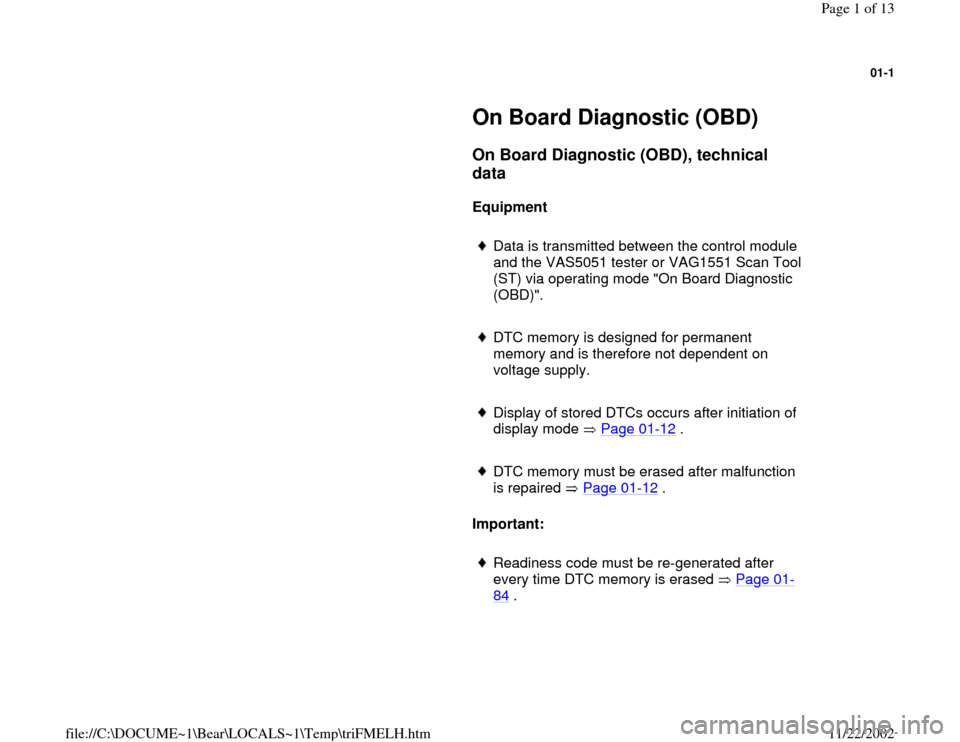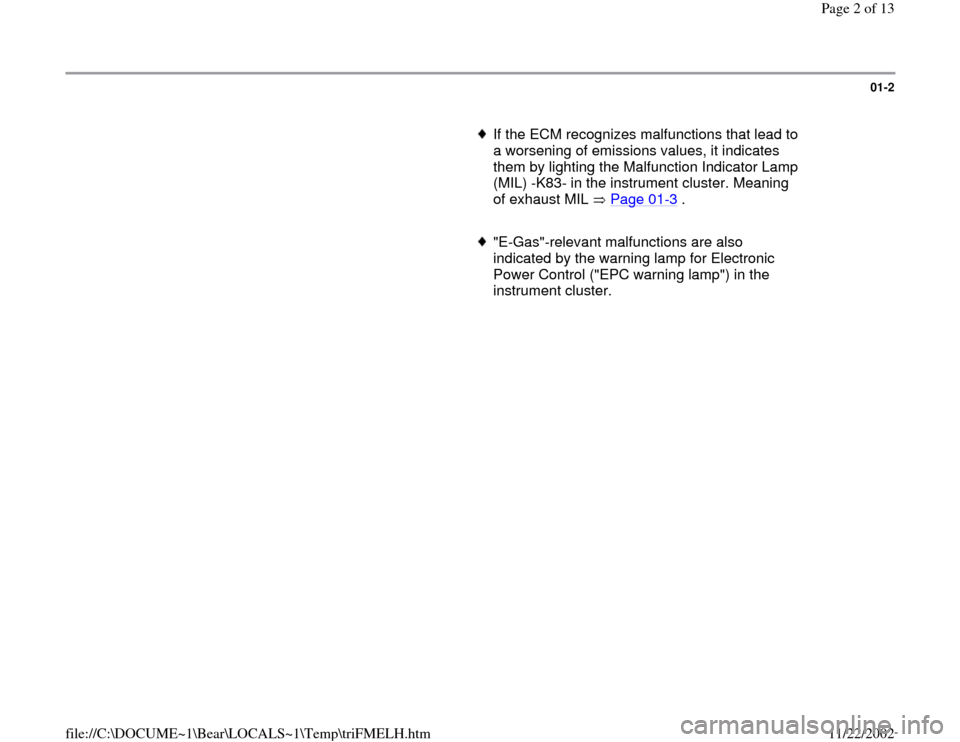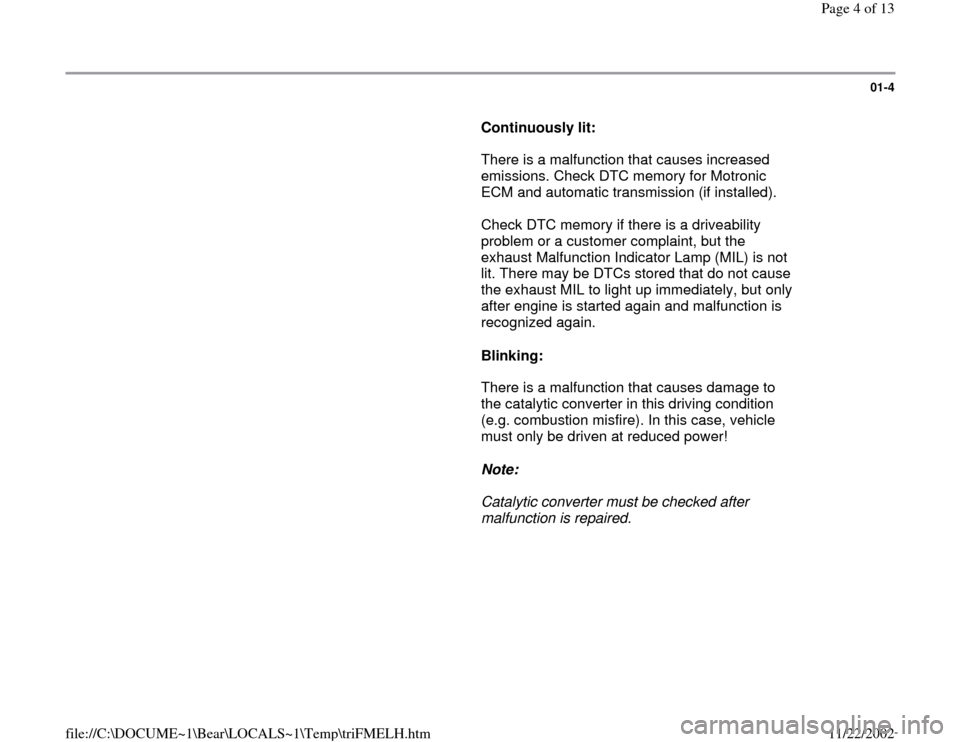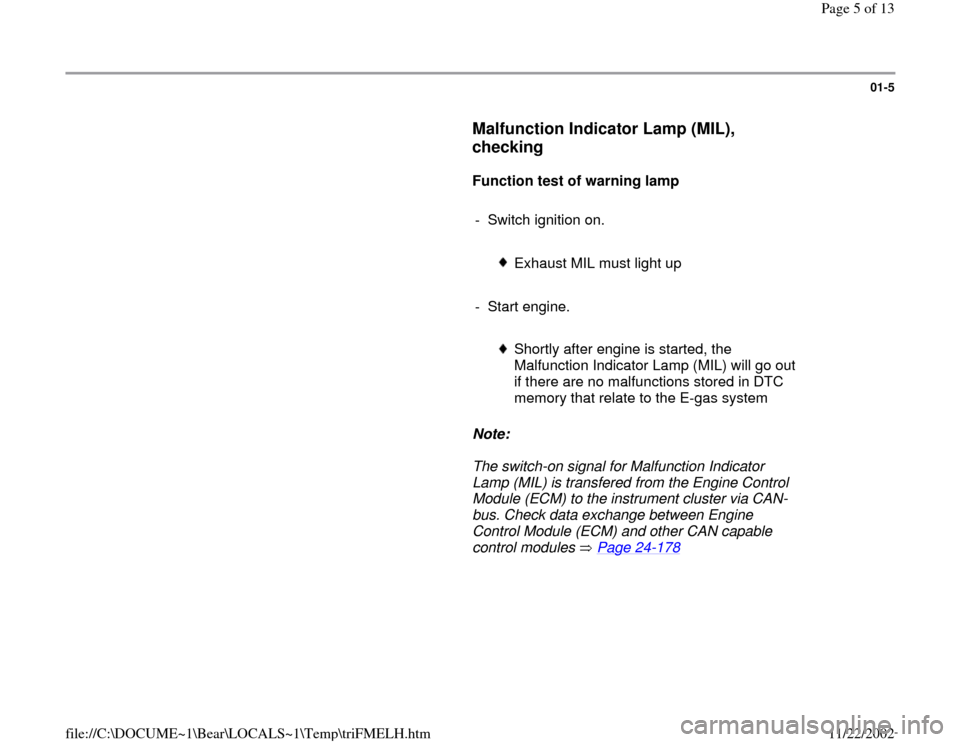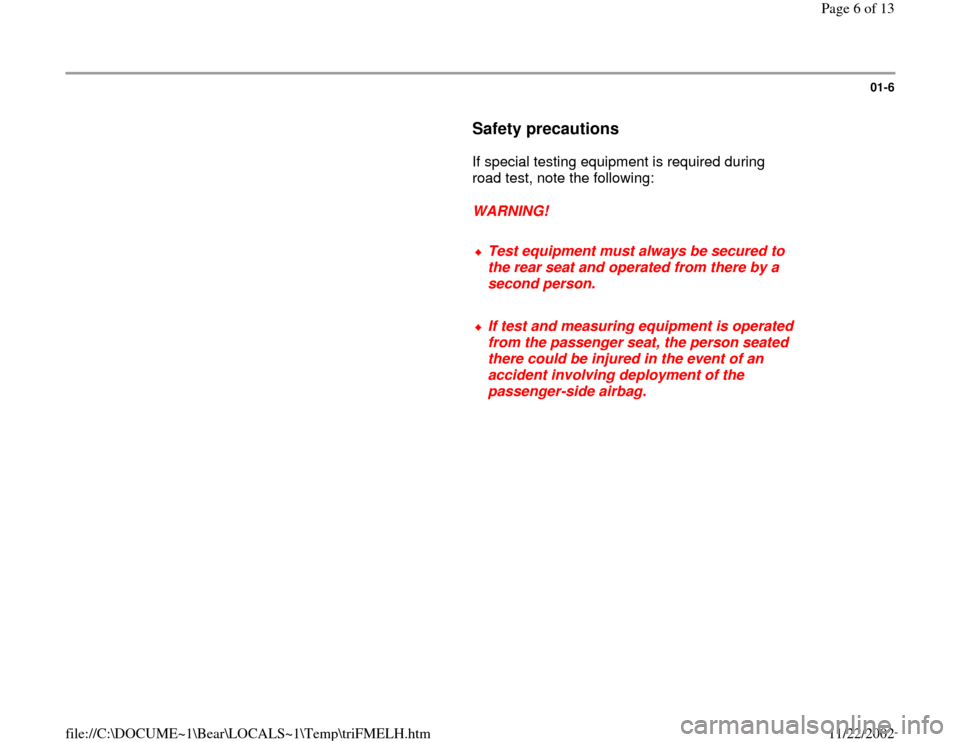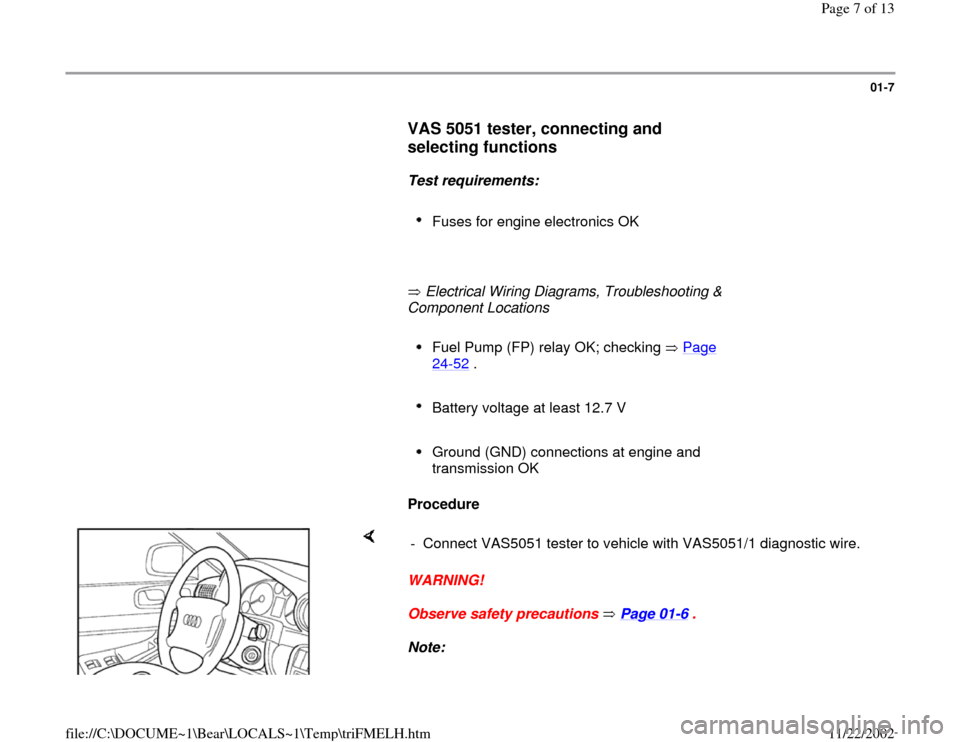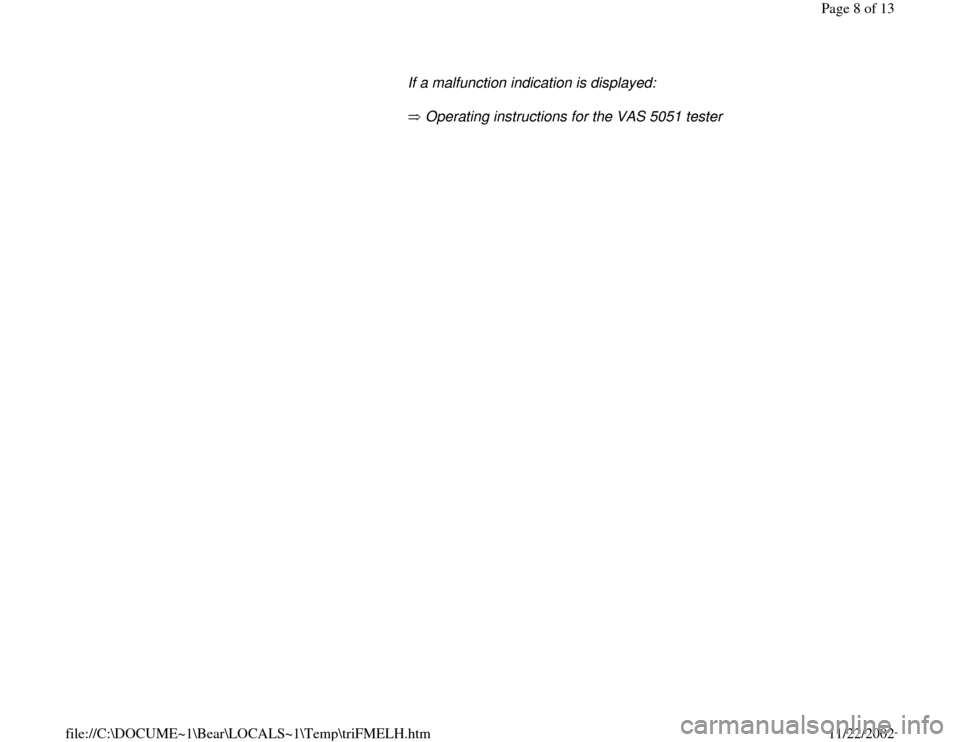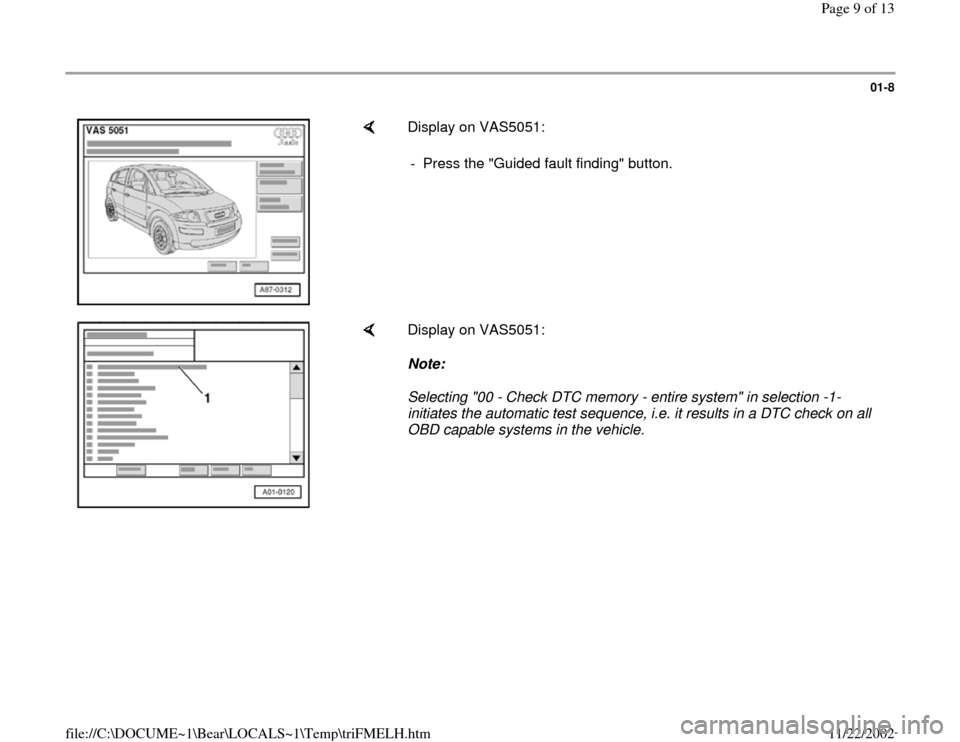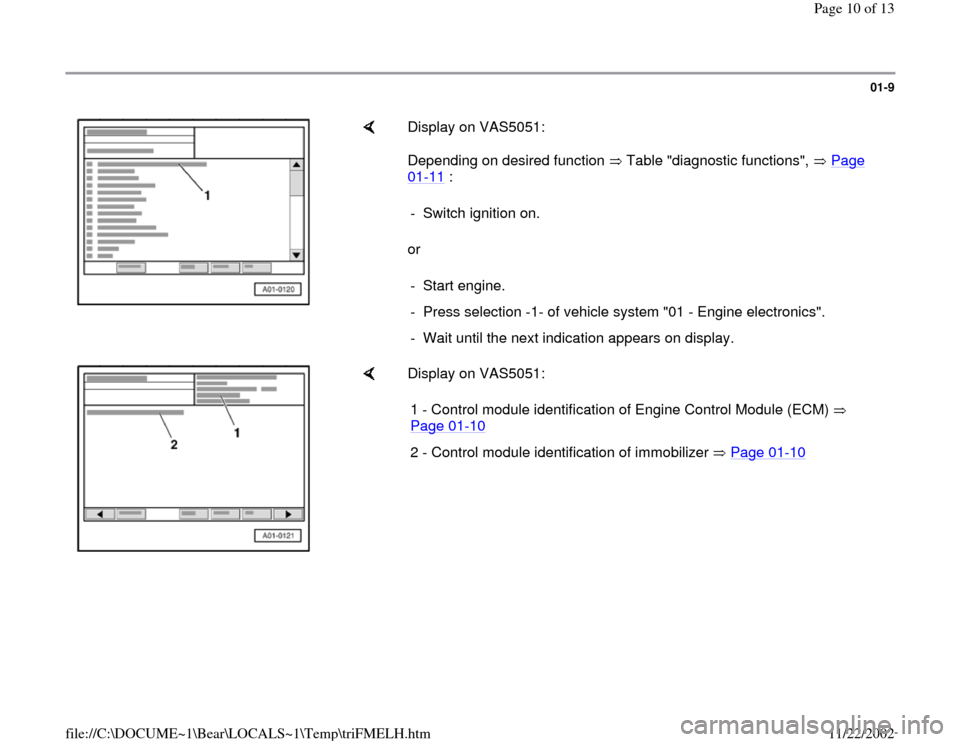AUDI A4 2000 B5 / 1.G AWM Engine On Board Diagnostic Workshop Manual
Manufacturer: AUDI, Model Year: 2000,
Model line: A4,
Model: AUDI A4 2000 B5 / 1.G
Pages: 13, PDF Size: 0.09 MB
AUDI A4 2000 B5 / 1.G AWM Engine On Board Diagnostic Workshop Manual
A4 2000 B5 / 1.G
AUDI
AUDI
https://www.carmanualsonline.info/img/6/1092/w960_1092-0.png
AUDI A4 2000 B5 / 1.G AWM Engine On Board Diagnostic Workshop Manual
Trending: fuse, OBD port, cruise control, warning light, instrument cluster, airbag, transmission
Page 1 of 13
01-1
On Board Diagnostic (OBD)
On Board Diagnostic (OBD), technical
data
Equipment
Data is transmitted between the control module
and the VAS5051 tester or VAG1551 Scan Tool
(ST) via operating mode "On Board Diagnostic
(OBD)".
DTC memory is designed for permanent
memory and is therefore not dependent on
voltage supply.
Display of stored DTCs occurs after initiation of
display mode Page 01
-12
.
DTC memory must be erased after malfunction
is repaired Page 01
-12
.
Important:
Readiness code must be re-generated after
every time DTC memory is erased Page 01
-
84
.
Pa
ge 1 of 13
11/22/2002 file://C:\DOCUME~1\Bear\LOCALS~1\Tem
p\triFMELH.htm
Page 2 of 13
01-2
If the ECM recognizes malfunctions that lead to
a worsening of emissions values, it indicates
them by lighting the Malfunction Indicator Lamp
(MIL) -K83- in the instrument cluster. Meaning
of exhaust MIL Page 01
-3 .
"E-Gas"-relevant malfunctions are also
indicated by the warning lamp for Electronic
Power Control ("EPC warning lamp") in the
instrument cluster.
Pa
ge 2 of 13
11/22/2002 file://C:\DOCUME~1\Bear\LOCALS~1\Tem
p\triFMELH.htm
Page 3 of 13
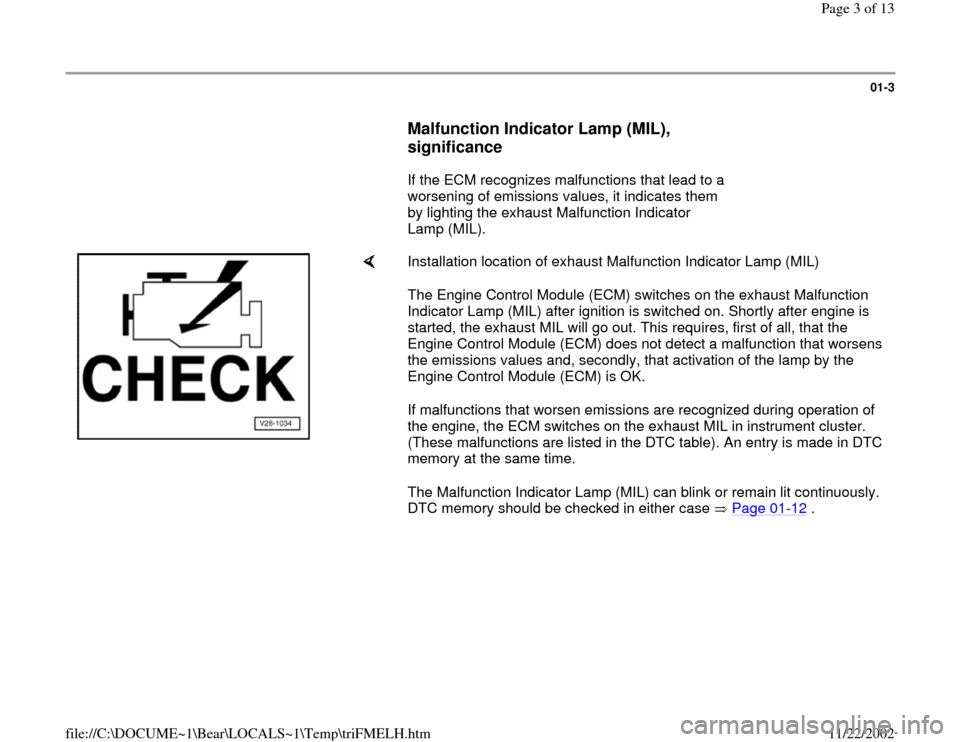
01-3
Malfunction Indicator Lamp (MIL),
significance
If the ECM recognizes malfunctions that lead to a
worsening of emissions values, it indicates them
by lighting the exhaust Malfunction Indicator
Lamp (MIL).
Installation location of exhaust Malfunction Indicator Lamp (MIL)
The Engine Control Module (ECM) switches on the exhaust Malfunction
Indicator Lamp (MIL) after ignition is switched on. Shortly after engine is
started, the exhaust MIL will go out. This requires, first of all, that the
Engine Control Module (ECM) does not detect a malfunction that worsens
the emissions values and, secondly, that activation of the lamp by the
Engine Control Module (ECM) is OK.
If malfunctions that worsen emissions are recognized during operation of
the engine, the ECM switches on the exhaust MIL in instrument cluster.
(These malfunctions are listed in the DTC table). An entry is made in DTC
memory at the same time.
The Malfunction Indicator Lamp (MIL) can blink or remain lit continuously.
DTC memory should be checked in either case Page 01
-12
.
Pa
ge 3 of 13
11/22/2002 file://C:\DOCUME~1\Bear\LOCALS~1\Tem
p\triFMELH.htm
Page 4 of 13
01-4
Continuously lit:
There is a malfunction that causes increased
emissions. Check DTC memory for Motronic
ECM and automatic transmission (if installed).
Check DTC memory if there is a driveability
problem or a customer complaint, but the
exhaust Malfunction Indicator Lamp (MIL) is not
lit. There may be DTCs stored that do not cause
the exhaust MIL to light up immediately, but only
after engine is started again and malfunction is
recognized again.
Blinking:
There is a malfunction that causes damage to
the catalytic converter in this driving condition
(e.g. combustion misfire). In this case, vehicle
must only be driven at reduced power!
Note:
Catalytic converter must be checked after
malfunction is repaired.
Pa
ge 4 of 13
11/22/2002 file://C:\DOCUME~1\Bear\LOCALS~1\Tem
p\triFMELH.htm
Page 5 of 13
01-5
Malfunction Indicator Lamp (MIL),
checking
Function test of warning lamp
- Switch ignition on.
Exhaust MIL must light up
- Start engine.
Shortly after engine is started, the
Malfunction Indicator Lamp (MIL) will go out
if there are no malfunctions stored in DTC
memory that relate to the E-gas system
Note:
The switch-on signal for Malfunction Indicator
Lamp (MIL) is transfered from the Engine Control
Module (ECM) to the instrument cluster via CAN-
bus. Check data exchange between Engine
Control Module (ECM) and other CAN capable
control modules Page 24
-178
Pa
ge 5 of 13
11/22/2002 file://C:\DOCUME~1\Bear\LOCALS~1\Tem
p\triFMELH.htm
Page 6 of 13
01-6
Safety precautions
If special testing equipment is required during
road test, note the following:
WARNING!
Test equipment must always be secured to
the rear seat and operated from there by a
second person.
If test and measuring equipment is operated
from the passenger seat, the person seated
there could be injured in the event of an
accident involving deployment of the
passenger-side airbag.
Pa
ge 6 of 13
11/22/2002 file://C:\DOCUME~1\Bear\LOCALS~1\Tem
p\triFMELH.htm
Page 7 of 13
01-7
VAS 5051 tester, connecting and
selecting functions
Test requirements:
Fuses for engine electronics OK
Electrical Wiring Diagrams, Troubleshooting &
Component Locations
Fuel Pump (FP) relay OK; checking Page 24
-52
.
Battery voltage at least 12.7 V
Ground (GND) connections at engine and
transmission OK
Procedure
WARNING!
Observe safety precautions Page 01
-6 .
Note: - Connect VAS5051 tester to vehicle with VAS5051/1 diagnostic wire.
Pa
ge 7 of 13
11/22/2002 file://C:\DOCUME~1\Bear\LOCALS~1\Tem
p\triFMELH.htm
Page 8 of 13
If a malfunction indication is displayed:
Operating instructions for the VAS 5051 tester
Pa
ge 8 of 13
11/22/2002 file://C:\DOCUME~1\Bear\LOCALS~1\Tem
p\triFMELH.htm
Page 9 of 13
01-8
Display on VAS5051:
- Press the "Guided fault finding" button.
Display on VAS5051:
Note:
Selecting "00 - Check DTC memory - entire system" in selection -1-
initiates the automatic test sequence, i.e. it results in a DTC check on all
OBD capable systems in the vehicle.
Pa
ge 9 of 13
11/22/2002 file://C:\DOCUME~1\Bear\LOCALS~1\Tem
p\triFMELH.htm
Page 10 of 13
01-9
Display on VAS5051:
Depending on desired function Table "diagnostic functions", Page 01
-11
:
or
- Switch ignition on.
- Start engine.
- Press selection -1- of vehicle system "01 - Engine electronics".
- Wait until the next indication appears on display.
Display on VAS5051:
1 - Control module identification of Engine Control Module (ECM)
Page 01
-10
2 - Control module identification of immobilizer Page 01
-10
Pa
ge 10 of 1311/22/2002 file://C:\DOCUME~1\Bear\LOCALS~1\Tem
p\triFMELH.htm
Trending: check engine, immobilizer, transmission, warning, instrument cluster, light, technical data
